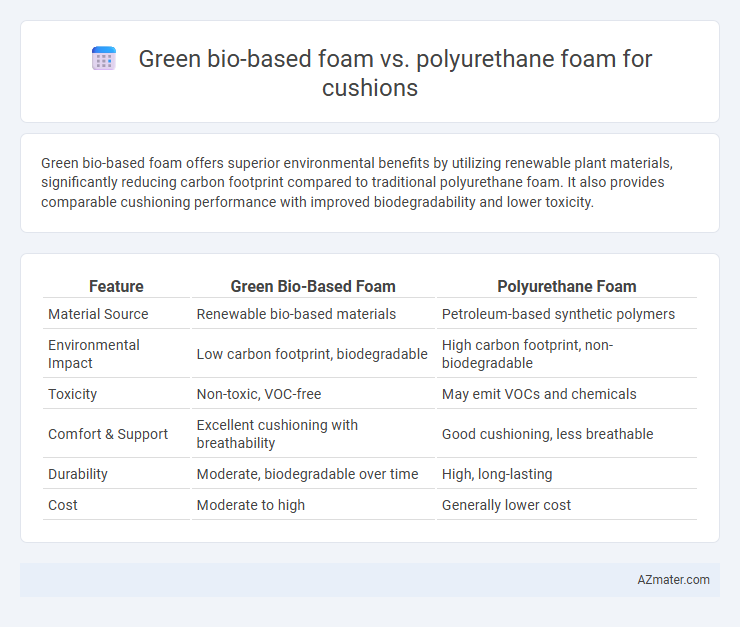Green bio-based foam offers superior environmental benefits by utilizing renewable plant materials, significantly reducing carbon footprint compared to traditional polyurethane foam. It also provides comparable cushioning performance with improved biodegradability and lower toxicity.
Table of Comparison
| Feature | Green Bio-Based Foam | Polyurethane Foam |
|---|---|---|
| Material Source | Renewable bio-based materials | Petroleum-based synthetic polymers |
| Environmental Impact | Low carbon footprint, biodegradable | High carbon footprint, non-biodegradable |
| Toxicity | Non-toxic, VOC-free | May emit VOCs and chemicals |
| Comfort & Support | Excellent cushioning with breathability | Good cushioning, less breathable |
| Durability | Moderate, biodegradable over time | High, long-lasting |
| Cost | Moderate to high | Generally lower cost |
Introduction to Cushion Foams: Green Bio-Based vs Polyurethane
Cushion foams play a critical role in comfort and durability across furniture and automotive industries, with green bio-based foams emerging as sustainable alternatives to traditional polyurethane foams. Green bio-based foams utilize renewable resources like soy, castor oil, or starch, reducing reliance on petroleum and lowering carbon footprints compared to petroleum-derived polyurethane foams. Polyurethane foams offer established performance characteristics such as high resilience, adjustable density, and proven durability, while bio-based foams increasingly match these qualities with added environmental benefits.
Environmental Impact: Bio-Based Foam vs Polyurethane
Green bio-based foam significantly reduces carbon footprint by utilizing renewable resources such as plant oils, unlike traditional polyurethane foam derived from petroleum-based chemicals. The biodegradability and lower VOC emissions of bio-based foam contribute to improved indoor air quality and reduced landfill burden. Polyurethane foam's reliance on non-renewable fossil fuels and its slow decomposition intensify environmental pollution and resource depletion.
Raw Materials Source and Sustainability
Green bio-based foam derives primarily from renewable resources such as plant oils, starches, and natural fibers, significantly reducing reliance on fossil fuels compared to traditional polyurethane foam made from petrochemical raw materials. The sustainability of bio-based foam is enhanced by its lower carbon footprint, biodegradability, and potential for composting, contrasting with polyurethane's persistence in landfills and challenges in recycling. Choosing bio-based foam for cushions supports circular economy principles and promotes reduced environmental impact throughout the product lifecycle.
Manufacturing Process Comparison
Green bio-based foam is produced using renewable resources such as plant oils and starches through processes like microbial fermentation or chemical modification of biopolymers, resulting in lower carbon emissions and reduced reliance on fossil fuels. Polyurethane foam manufacturing involves the polymerization of petrochemical-derived polyols and isocyanates, requiring high energy input and generating significant volatile organic compounds (VOCs) and hazardous waste. The green bio-based foam process emphasizes sustainability with biodegradable and non-toxic components, while polyurethane foam focuses on cost efficiency and mechanical durability despite environmental concerns.
Physical Properties and Performance
Green bio-based foam offers enhanced breathability and lower density compared to traditional polyurethane foam, resulting in superior comfort and reduced heat retention in cushions. Its open-cell structure provides better moisture management and resilience under prolonged compression, ensuring long-term durability and shape retention. Polyurethane foam typically exhibits higher firmness and abrasion resistance but may degrade faster due to its petroleum-based composition and limited environmental adaptability.
Durability and Lifespan Analysis
Green bio-based foam offers enhanced durability compared to traditional polyurethane foam due to its advanced polymer structure and higher resistance to compression and degradation. Polyurethane foam typically exhibits a shorter lifespan, averaging 5 to 10 years with significant loss of support over time, whereas bio-based foam can maintain structural integrity for 10 to 15 years under similar usage conditions. The improved oxidation resistance and moisture-wicking properties of green bio-based foam contribute to its longer-lasting performance in cushion applications.
Comfort and User Experience
Green bio-based foam offers superior breathability and moisture-wicking properties compared to traditional polyurethane foam, enhancing overall comfort during prolonged use. Its natural materials provide better temperature regulation and reduce skin irritation, resulting in a more pleasant user experience. Polyurethane foam, while durable and supportive, often lacks the eco-friendly benefits and long-term comfort that green bio-based alternatives deliver.
Cost and Market Availability
Green bio-based foam typically incurs higher production costs compared to conventional polyurethane foam due to its reliance on renewable, plant-derived materials and newer manufacturing processes. Polyurethane foam dominates the cushion market with extensive availability, widespread manufacturing infrastructure, and lower price points, making it the preferred choice for cost-sensitive applications. Despite premium pricing, the growing demand for sustainable products is expanding the market presence of green bio-based foam, gradually improving its cost competitiveness and accessibility.
Health and Indoor Air Quality
Green bio-based foam significantly reduces volatile organic compound (VOC) emissions compared to traditional polyurethane foam, enhancing indoor air quality and minimizing respiratory irritants. Derived from natural materials like soy, castor oil, or algae, bio-based foams offer hypoallergenic properties and lower off-gassing profiles, supporting healthier living environments. In contrast, polyurethane foam often contains synthetic chemicals and flame retardants that can emit formaldehyde and other harmful pollutants over time.
Future Trends and Innovations in Cushion Foams
Green bio-based foam is rapidly advancing with innovations that enhance sustainability, biodegradability, and non-toxic properties, making it a preferred choice for eco-conscious cushion manufacturing. Polyurethane foam continues to improve with new formulations that increase durability, comfort, and fire resistance, driven by advancements in chemical engineering and recycling technologies. Future trends point toward hybrid foams combining bio-based materials and polyurethane to optimize performance, environmental impact, and cost-efficiency in cushion applications.

Infographic: Green bio-based foam vs Polyurethane foam for Cushion
 azmater.com
azmater.com